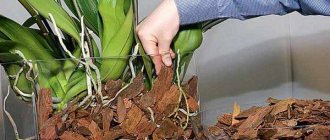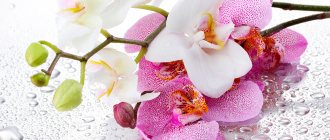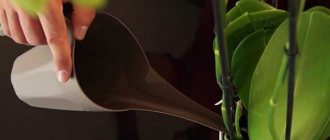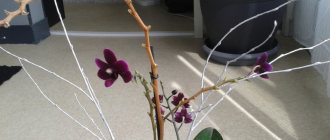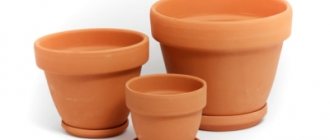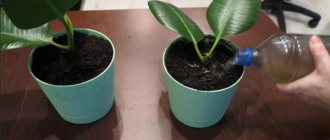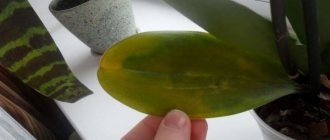The tropical beauty of the orchid will not leave anyone indifferent.
This flower grows well in Russian apartments, although it is quite capricious. The orchid is the most demanding regarding the frequency and abundance of watering, as well as the quality of water. In this article we will tell you everything about how to irrigate an orchid, as well as what nuances to pay special attention to. Dear readers! For you, we have created communities on social networks in which useful articles and interesting ideas are published several times a day! Subscribe and receive useful content in a convenient format!
How to determine that an orchid needs watering?
Irrigation should be carried out as the soil in the pot dries. The flower does not like excessive humidity, but also does not tolerate periods of drought. There are several tricks to determine the need for watering.
Look at the walls of the pot; if there is condensation on them, then there is no need to water. If the aerial roots become pale, then you need to irrigate. And, conversely, a flower with bright green roots is not watered.
If your orchid grows in an opaque pot, then you can determine the degree of dryness of the soil using a stick stuck into the substrate. Another way is to take the pot in your hands. If it is heavy, with a center of gravity closer to the bottom, it means there is still a lot of moisture in it, and there is no need to water the flower.
IMPORTANT! The liquid you will use must sit and warm up. The ideal option is to collect rainwater. When using ordinary tap or well water, reduce its hardness level with oxalic acid (half a teaspoon per three-liter jar).
How to correctly understand that it is time?
Each plant differs in the frequency and intensity of watering. The orchid prefers to be in semi-dry soil rather than grow from a well-moistened substrate. It is not easy to maintain a fine line, not to dry out or over-moisten the soil.
Between procedures, the substrate should dry well. Several signs will help identify the need for moisture:
- “light” pot;
- absence of drops on substrate particles and plant roots;
- light gray color of the roots (green roots indicate good moisture).
How often to water an orchid?
The orchid does not require frequent watering, but it should be plentiful. The fact is that frequent addition of water entails the accumulation of moisture in the pot. And this is a direct road to the development of rot and the subsequent death of the flower.
At the same time, you need to water the plant abundantly so that the orchid drinks enough. Due to lack of moisture, the growth of the orchid will slow down and flowering will become poor.
How often you water is directly dependent on 2 factors: the time of year and the phase of plant development.
In winter, you need to water the orchid no more than 2-3 times a month. In summer, watering is carried out more often - every 3-4 days, plus it is additionally necessary to increase the air humidity. For example, using a saucer filled with water placed next to the orchid.
Soil and pot at home
The royal orchid attracts with its beauty and grandeur. At the same time, it is not easy to provide the plant with comfortable conditions in which it will bloom like in the wild. In nature, the flower is accustomed to growing on trees and receiving nutrition through aerial roots.
Breeding orchids at home became possible after the development of less demanding hybrids, but they also require a special moisture-intensive substrate. You can prepare the soil yourself using tree bark, expanded clay, sphagnum moss, coal and other components.
The soil for the flower must meet three main criteria:
- have the ability to retain water for the root system;
- keep moisture in the pot for no more than four days;
- be loose and allow air to pass through well.
The root system must be in a clay or plastic pot, which must meet the following requirements:
- the volume of the pot corresponds to the size of the roots;
- the lower side of the pot has many drainage holes;
- transparent material (for epiphytic plants).
Read more about how to choose a flower pot here.
Watering methods
An orchid is a very capricious flower that needs to be watered in different ways. Let's take a closer look at them.
Hot shower
Watering is carried out from a watering can with very warm (40 degrees) water. The water pressure should not be strong. It is necessary to water until the soil under the orchid is completely saturated.
After the procedure, let the water drain and the plant rest a little. Then carefully remove excess moisture from the leaves, axils and shoots. There is no need to immediately move the plant to a cold room, otherwise it will get sick. So give him some time to “come to his senses.”
This method of watering imitates a tropical rainfall and also removes dust and dirt from the flower.
IMPORTANT! With this method of irrigation, it is not advisable to use tap water. It is not suitable for an orchid. Better buy a small watering can with a nozzle.
Spraying the roots
This method is used for flowers that grow without a substrate. They need to be irrigated as often as possible, since their need for moisture is higher. The procedure is carried out in the morning. Select the finest spray on the spray bottle so that the water looks like fog or suspension.
Interestingly, this irrigation method can occasionally be used for those orchids that are grown in the usual way.
Watering into a tray
It is best to grow an orchid in a special pot with a deep tray. Then watering the flower is done by adding water to this pan. The substrate is gradually saturated with water. As a result, the pot maintains the optimal level of humidity required for the flower.
Dive
This method is reminiscent of watering in a tray, which is usual for orchids. Only you simply lower the orchid pot into a prepared container with liquid for 10 minutes. This time is usually enough for the soil in the pot to become saturated with liquid. But be careful! Neither the stem, nor the leaves, and especially the flowers, should touch the water in the pan.
Surface watering
And this is the most common watering method. Using a watering can with a long spout, you carefully pour the liquid over the entire surface of the substrate. Water should flow out of the drainage holes. You need to repeat the procedure several times. This method is used only for morning moisturizing.
Basic principles of caring for home orchids
How to care for and how to properly water an orchid? The main task of the gardener is to understand that growing an exotic plant is noticeably different from ordinary terrestrial house plants. And before purchasing a tropical orchid, you need to become familiar with its biological characteristics and way of life in natural conditions that are natural for an orchid.
The orchid needs to create good living conditions.
Caring for an indoor orchid requires the correct creation of growing conditions. There are 5 basic principles of the life of orchids in the natural environment, which you should pay attention to when growing at home:
- Sufficient amount of diffused light . Growing in the tropics on tree trunks, orchids, climbing the trunk, are drawn to sunlight, but do not fall under the bright rays of the sun, since the tree crowns scatter them;
- Temperature difference between day and night . In orchids, the process of photosynthesis also has a dark phase at night, when carbon dioxide is reduced to glucose. The leaf mass and root system of orchids are included in the stage of absorption of carbon dioxide required for photosynthesis only when the temperature decreases, when there is no evaporation of moisture;
- The structure of the root system of epiphytes is such that it has no restrictions on moisture absorption . Therefore, it needs good ventilation to avoid rotting. And the life activity of the root part occurs without soil, but with a large presence of air;
- Tropical humidity at home is compensated by a properly selected substrate. It is the main accumulator of moisture and nutrition;
- In nature, orchids bloom after a period of tropical rains . Therefore, watering in an apartment should be properly alternated with drying. And before flowering, the plant must trust the owner that the rainy season is over and the time for pollination is coming.
Attention! It is these 5 life principles that help the gardener optimize the growing process and create conditions close to natural.
How to water at different times?
Depending on the time of year, some nuances of the procedure vary. Let's look at them in a little more detail.
in winter
In winter, the orchid most often “rests,” so it rarely needs to be watered. For normal growth and development of the flower, one irrigation every two weeks will be enough. At the same time, be sure to monitor the air humidity. Due to the central heating radiators, the apartment may be too dry for the flower. However, you cannot spray the flower at this time of year.
In summer
During the summer months, the orchid requires a lot of liquid. You will have to water the flower every 3-4 days. Also, do not forget about a hot shower and spraying. To maintain the required level of humidity, place a saucer with wet pebbles, water or moss next to the orchid pot.
Spring and autumn
In spring, watering becomes more frequent compared to the winter months. At this time of year, you need to gradually switch to the summer watering schedule. In autumn, on the contrary, the number of water procedures is gradually reduced. However, it is still possible to carry out sanitary spraying to wash away dust and dirt from the leaves and give them a decorative appearance.
Selecting a location
Lighting
Diffused, not too intense light is the best option for tropical pets. Direct sunlight not only leads to leaf burns, but also overheats the root system, which negatively affects development.
Insufficient lighting is even more harmful than too much lighting. The plant often :
- Sick;
- Slows down;
- Or even its growth stops completely;
- Flowering stops, etc.
An important component for the grower is the choice of growing location :
- South and south-east windows in the summer have too intense light plus an abundance of direct sunlight. On this side it is better to place the orchid away from the window and shade it with parchment paper or tulle. On the south side they feel excellent: Wanda;
- Dendrobium;
- And Cymbidium.
In winter, additional lighting is often installed for orchids.
- Cumbria;
Temperature and humidity
The temperature range for orchids is quite wide:
- 17-28° C during the daytime;
- And 13-23° C at night.
Heat-loving species include :
- Phalaenopsis;
- Dendrobium;
- Vanda is a dwarf species;
- Paphiopedilum.
They are able to tolerate heat up to 35° C and are not so demanding on differences between night and day temperatures.
They prefer moderate temperatures from 20 to 22 ° C during the daytime and up to 15 ° C during the dark, such species as:
- Cattleya;
- Cymbidium;
- And Odontoglossum.
Coolness and high humidity are characteristic of such species as:
- Cumbria;
- Masdevaliyam;
- And the Miltonians.
It is important, especially in the hot season, to ventilate the room . Orchids require regular air circulation.
The humidity levels typical of city apartments are quite suitable for most orchids. On average, at home humidity is between 40-60%. High humidity of 75-90% is required for :
- Wanda;
- And Miltonia.
Advice! In summer, on hot days, the humidity is increased with a container of water and spraying. It is important for the gardener to learn how to manage this condition.
Features of watering orchids depending on the growing season
Growing seasons also make adjustments to the irrigation regime. Let's look at how to water an orchid at different stages of its growth.
Watering an orchid during flowering
During the phase of active peduncle formation and immediate flowering, the orchid requires more watering. But you need to pour water very carefully so as not to accidentally drip on the flowers. If your plant blooms in the warm months, then you need to water it about once every 4 days. If flowering occurs in the winter months, then you need to irrigate a little less often, approximately every 7-8 days.
How to water during dormancy
After flowering has ended, the substrate in the pot with the orchid is allowed to dry completely, a couple of days are counted, and then the orchid is watered. At this stage of plant development, you need to irrigate the flower no more than once every 2 weeks. In this case, you do not need to add a lot of liquid.
How to do the procedure after transplantation
As soon as you have transplanted the orchid, the soil in the pot must immediately be completely saturated with moisture. The immersion method is more suitable for this. It is necessary to lower the pot into the tray for half an hour. After this, the flower is left alone for 2 weeks, and then the watering procedure is repeated.
Features during flowering
Blooming is the most touching and beautiful time for orchids, but at the same time, the most difficult. So that it does not drop its buds, so that the flower is without flaws, so that the brightness and duration of flowering time does not change, you need to water the orchid with water at room temperature, neutralizing all foreign impurities.
How to water orchids depending on the variety and varieties, table
In the table below we have collected the most important aspects of watering the most popular varieties of indoor orchids.
| Variety of flower | Nuances of watering |
| Wanda | The preferred method is a hot shower. Irrigate only when the soil substrate is completely dry. |
| Lady's slipper | Regular watering: every 3-4 days in summer, every 7-8 days in winter. Do not allow the roots to dry out, as this can lead to the death of the flower. |
| Dendrobium | Abundant irrigation in spring and summer using the immersion method (keep in water for up to 1 hour). Reduce the frequency and volume of fluid administered during the rest period. |
| Cumbria | Spraying is not allowed. Water only when the soil is completely dry. |
| Cattleya | Water only when the soil in the pot dries completely. Increase watering when the ambient temperature rises. |
| Miltonia | During the warm season, irrigate three times a week. Do not allow the substrate to become waterlogged or dry out. |
| Oncidium | Abundant irrigation until pseudobulbs form. Then watering is stopped until flowering begins. |
| Phalaenopsis | During the budding and flowering phases, the flower is irrigated every 3 days. During the rest period - once every week and a half. During the stage of active growth and accumulation of green mass, irrigation is carried out every week. |
| Cymbidium | Preferred irrigation methods: submersion and surface irrigation. In summer, irrigation is once a week, in autumn - once every 1.5 weeks, in winter - once every 2 weeks, in spring - once a week. |
General provisions
Epiphytes - what are they and how do they grow in nature?
In nature, this exotic beauty grows on trees. But the flower is not a parasite, since it takes food for its development from the air and dead tree bark , which may be located in a crevice or other recess.
In this regard, the orchid belongs to the group of epiphytic plants growing on trees.
The structure of orchid roots
The roots of the plant consist of:
- Conductive thread;
- Parenchyma;
- Velamena;
- Apical tip of the root.
All parts are involved in photosynthesis of the plant and are vital for proper metabolism. With frequent watering, the velamen and parenchyma rot, exposing the root to a conductive thread. Therefore, drying of the flower is required.
Orchid root: 1 - Central cylinder; 2 - Epiblema; 3 - Velamen.
IMPORTANT! If the roots are exposed, the flower will need resuscitation efforts to build up the root system.
Basic rules of watering
When cultivating a plant, it is important to choose the right watering regime and water quality. Here are the basic rules for watering:
- Water the flower when the roots turn whitish or light gray. Green roots do not need watering;
- The bark should dry 2/3 of the container;
- The water used for irrigation should be warm, settled and soft. Water hardness can be reduced by boiling.
Sprinkling
You can bathe the plant in the shower - this is very useful . As a result, good leaves will grow and larger flowers will bloom.
Method of how to bathe an orchid using a shower to simulate rain:
- the plants are placed in the bathtub and watered with low pressure from the shower, but the water should be soft and warm 30-40 degrees ;
- imitate rain until the bark is completely wet, after which the flowers are left there so that the water completely drains from the substrate. There is no point in spraying water on the flowers ;
- after an hour, you need to wipe the sinuses of the leaf plates so that moisture does not accumulate there, which can lead to rotting of the leaf and its death. Especially the removal of moisture concerns such plant species as Phalaenopsis and Vanda.
Immersion method
Also very often, gardeners use immersion watering. This is used in most regions of Russia, because the water flowing from the tap is quite hard.
The main rules for how and how much to immerse orchids in water:
- water is prepared according to the parameters in advance;
- the container where the plant will be immersed must be of such a size that the immersed pot with a flower can wet its entire bark;
- immerse the container slowly so that the dry bark cannot push the roots of the flower into the air;
- The length of time plants should stand in water depends on the size of the root mass. Typically the dive lasts from 10 to 25 minutes ;
- After the watering procedure, you must allow the water to drain completely and only then place the container with the flower on the tray.
Immersion watering.
IMPORTANT! To prevent infection with a bacterial disease, watering must be organized for each flower separately.
How to spray correctly?
Spraying should be fine. The procedure is carried out from a distance of at least 20 cm so that large drops of water do not fall on the leaves.
Water for spraying must meet all the orchid’s liquid requirements, that is, be warm, settled and soft.
It is forbidden to spray those plants that have been in the sun for a long time. The procedure is not carried out in winter.
Improper watering and plant diseases?
As mentioned above, the orchid needs to be watered infrequently, but abundantly. A special feature of this plant is its ability to accumulate water in its tissues. If you water the plant too often, excess moisture will accumulate in the pot. As a result, this will lead to the development of putrefactive processes and fungal diseases.
ON A NOTE. Improper spraying is a common cause of leaf burns.
If you have several orchids, then when irrigating using the immersion method, the water must be completely changed. Otherwise, there is a chance to infect all the flowers.
What to do if the orchid is overwatered
The first sign that an orchid is flooded is darkened, wrinkled roots. Second, the leaves begin to turn yellow, wrinkle and fall off. All this ultimately leads to the death of the plant.
You can save the flower by replanting. Read about how to properly carry out this procedure in our article “Transplanting a Phalaenopsis orchid at home.”
What to do if the flower has dried up
At the first signs of drying, watering should be resumed immediately. The main symptoms of a lack of fluid are a drying flower, yellowed and limp leaves.
During resuscitation procedures, spraying and irrigation should be carried out using the immersion method.
However, there is no guarantee that the flower can be saved. Therefore, simply do not bring the plant to the point where it needs to be urgently saved.
Possible mistakes
Let's look at possible mistakes in irrigating orchids.
- Water remains in the sinuses and floods the growing points. Because of this, the orchid begins to rot. Fungal diseases develop, which lead to the death of the plant.
- Improperly prepared liquid. Cold or hard tap water is not suitable for this plant.
- Spraying at close range . Water during spraying should be in the form of a suspension. If you spray from a distance of less than 20 cm, large drops will fall on the leaves, flowers and axils.
- Excessive irrigation. This leads to rotting of the root system and death of the flower.
- Lack of watering. The opposite situation. The orchid grows poorly and blooms poorly. The plant loses its decorative effect.
Answers to frequently asked questions
Which watering method is best to choose?
You need to focus on the type of orchid. In general, it is better to alternate all methods. This way you will recreate the natural growing conditions of this plant as accurately as possible.
What kind of water does an orchid like?
Warm, not hard, settled. Experienced florists boil the liquid to kill all germs. The ideal option is to collect rainwater. But not everyone can afford it. So settle the irrigation liquid and warm it before the procedure.
How to accurately understand that a flower needs to be watered?
It is best to grow an orchid in a clear plastic pot. Then the need for irrigation can be determined visually. Otherwise, use a sharp stick to pierce the substrate. If the stick is wet, there is no need to water it.
Water quality
To water orchids, you can use regular tap water. You should first settle it in order to eliminate harmful impurities, heavy salts, which not only do not bring any benefit, but can also damage the flower. Only soft water is allowed. If your water supply comes from hard water, you should not use it. Only soft water is suitable for orchids.
On a note! It is allowed to use not only tap water, but also settled rainwater and distilled water. It is advisable to boil the liquid in advance or purify it by passing it through a filter.
Rainwater
If you decide to store rainwater to water your orchids, you must adhere to these rules.
- Collect liquid outside the city limits so that the plantings are not negatively affected by dust, which is found in large quantities in urban environments.
- After collecting rainwater, store it in a cool place. This way you can reduce the rate of bacterial growth.
Rainwater is most suitable for watering orchids. It is not always possible to use it, since in the city rainwater can do more harm than good. To avoid damaging the flower, it is necessary to store water in proper conditions.
Boiled water
If you notice increased water hardness, you need to boil it. This will make the liquid softer. There are no harmful effects of boiled water on plants. Hard water needs to be boiled.
Distilled water
If you decide to water your orchids with distilled water, you need to dilute it with tap water, focusing on the level of hardness. If the water is very hard, you need to dilute it with tap water in a ratio of 1:2. If the liquid is of medium hardness, it is enough to mix it in a 1:1 ratio.
When using distilled water, you can independently determine the desired level of salt content and adjust it by changing the proportions.
Among the disadvantages of watering with distilled water is the high cost. The money spent is especially noticeable if the grower breeds orchids in large quantities.
Filtered liquid
If you use special filters to purify running water, you can quickly remove heavy metals and dangerous bacteria from the water. Purified water is more suitable for irrigation than regular tap water. In most cases, a large amount of money is not spent on water purification.
Among the disadvantages of watering with filtered water is the low cleaning speed, especially when caring for a large number of orchids. To speed up the growth and development of an orchid, it is advisable to pay attention to the acidity of the water. The optimal indicator is pH5. To determine the acidity level, you need to use litmus paper. Moisture enriched with oxygen is beneficial for an orchid. To enrich water, just pour it from one container to another.
